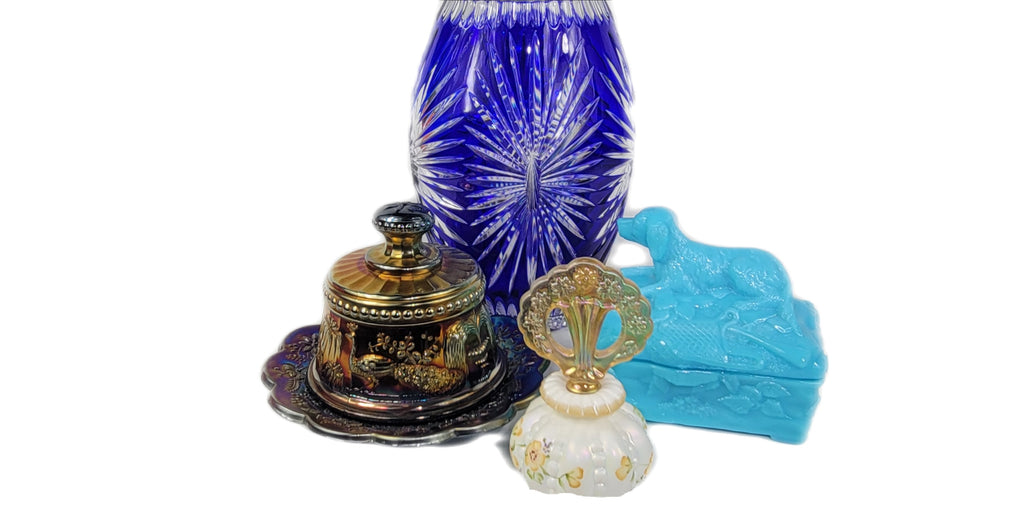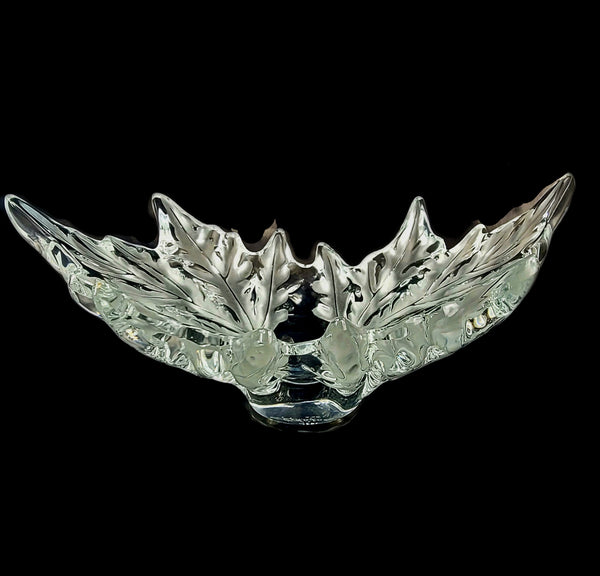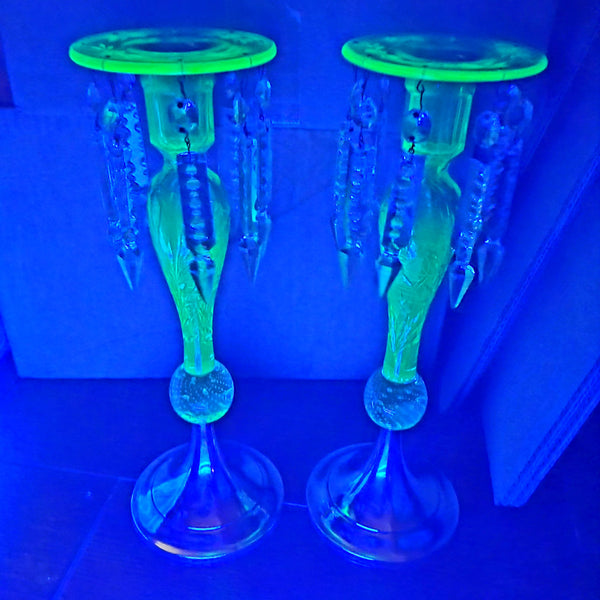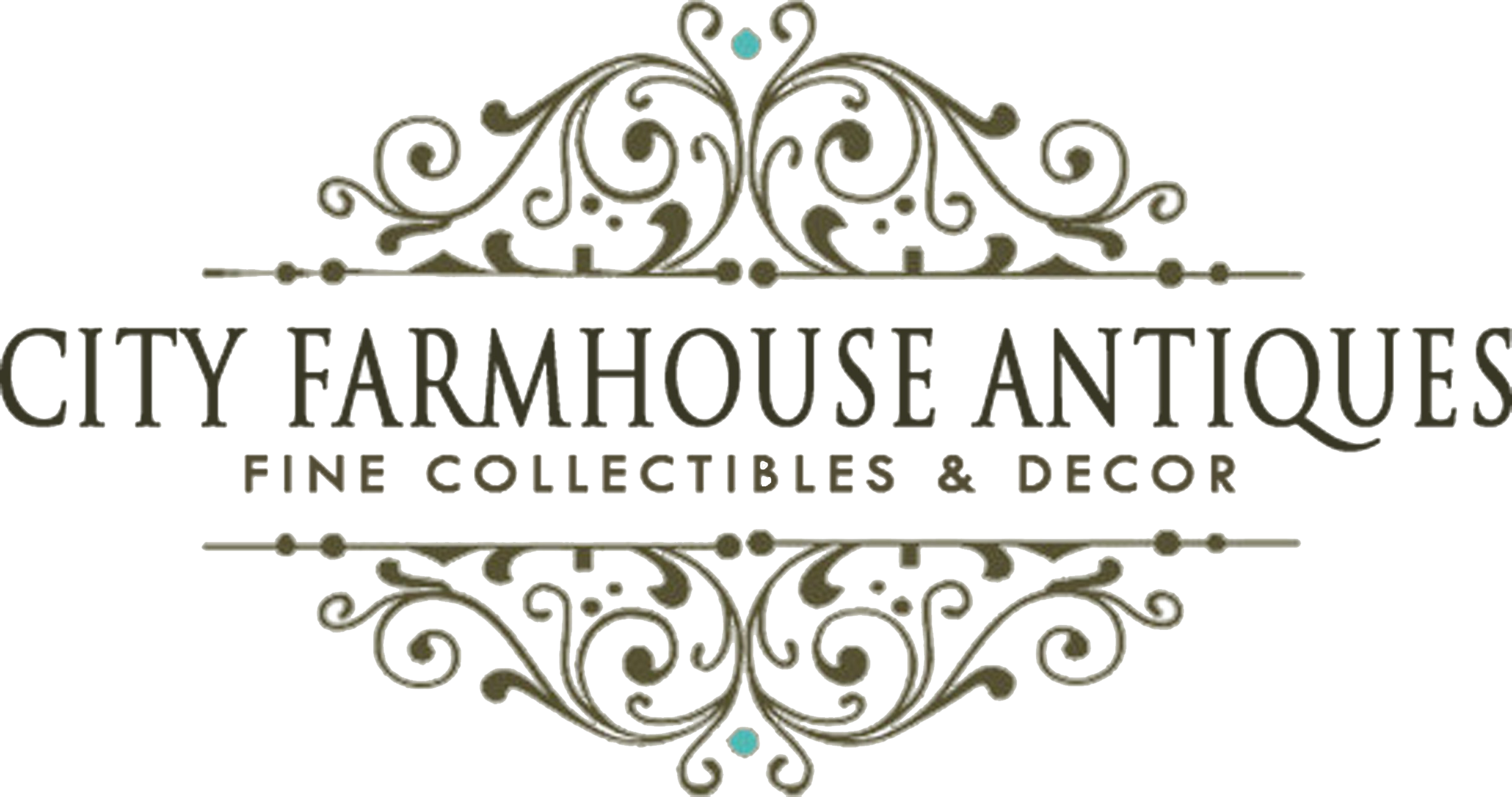How to Identify Antique Glass

Find our entire collection of glass. Video Transcription: Hi, this is Jennifer with City Farmhouse Antiques. I wanted to give you some tips on how to identify antique glass based on some characteristics and different colors and different shapes of these pieces. Let's get started by looking at some of these beautiful pieces that are up on the website at www.cityfarmhouseantiques.com and if you see something that you like that you don't see on the website message us in the chatbox or message us on the website and we will get back to you. This is an antique butter dish. It is carnival glass and I know that because of its beautiful iridescent colors and it also has mold marks. Here you can see the mold marks that we talked about in the last video. This is in the beautiful peacock at the fountains pattern. Isn't this piece beautiful? There you can see the fountains. When you take the top piece off you can see it is marked with an N for Northwood. Beautiful iridescense on this piece. That is not a scratch that is a piece of hair. No, that is a straw mark. This is a perfect example of a straw mark which is common in these old pieces and that would be normal not considered to be damage. However, this piece does look like, from the mold, or when it was made, the handle doesn't seem to be completely straight depending upon how you turn it. I love this pattern. You can tell this piece is not hand blown because there is no pontil on the bottom. To compare, here is a piece of Murano glass. This we know is hand blown which gives us a hint it is Murano. See the pontil on the bottom? That little round area. That is where the ball of molten glass actually came off the punt or stick before it was blown. That tells us this piece is hand blown and Murano glass is hand blown and we know that this is a very thick and heavy piece of glass which Murano glass is also known for. This piece is done in the sommerso technique. Depending upon the type of metal they added to the glass that is how the glass gets its different colors. This is a crystal vase. This is what we would call cut to clear. When they do a piece like this it is done with multiple layers of glass in different colors so you can see it is cut through in this pattern and when they cut through the cobalt blue glass it reveals the clear crystal beneath in this pattern. Beautiful vase and as you turn it you can see the double sided design and the design on the bottom. This one is probably about 14 inches tall. This piece is very heavy. Of course the heavier it is, the more the lead content, the more the lead content the better made and valuable the piece. These are little pieces of opaline colored glass. You can see how they have some opalescence to them. Opaline can be in this beautiful shimmery off white like this melon shaped perfume bottle done by Fenton glass. This is also opaline and this is a beautiful blue opaline. This is a cute trinket dish of a hunting dog. There you can see the rifle and the hunter's bag with the bird dog that rests on top. Really cute piece. This is a piece of cranberry glass in the diamond quilt pattern. This is a piece of milk glass because it looks like milk. In the old days everyone wanted to emulate high end china or porcelain so they created milk glass to look like expensive porcelain. You can see this has a grape pattern. You can find milk glass in all kinds of places and it typically has mold marks. This is something different. This is what is called Jadeite and is the color of a light Jade. You can see the mold marks on this so you know that is not hand blown. These are really cool. Let me take a few of these down to show you. These are from the late 1800's and are antique glass shades. These I know I don't have up on the website yet. These are opalescent so you can see they are translucent. You can see they aren't completely clear and even have a little pink around the rim. This is a lamp shade and whenever you see this pattern of bumps this is called hobnail. This is a hobnail opalescent lamp shade. Pretty cool. I have two of them. You could probably use these on any lamp. This is a piece of Early American Pattern Glass from the late 1800's. This is a holly pattern. You can see the mold marks from being pressed into the mold. This type of glass is on the cheaper end of the spectrum as far as old glass. This piece would have its own set. This is the creamer, but there is a sugar, spooner, etc and all the pieces that go with the set. I will show you this one last piece. This is a mid century piece. You can tell it is kind of that mid century modern type of look with an applied handle which means the handle was formed separately and then attached. This is amberina in color and this is cased glass so you can see how this piece is cased in another coat of glass. This actually has a little repair here that you can see. This would be mid century modern like 60's 70's and would be called an ewer becuase of the squatty little decanter shape. You can tell this piece is hand blown because there is the pontil on the bottom. It has a polished pontil and is not rough. Hope these tips and examples help to more easily identify antique glass.
Leave a comment
Comments will be approved before showing up.




